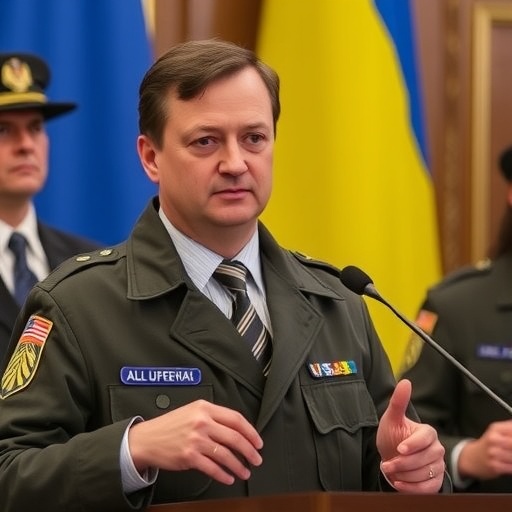Zelensky Urges U.S. to Escalate Sanctions on Russian Oil Sector Amid Ukraine’s Desperate Defense Push
In a stark reminder of the unrelenting toll of Russia’s invasion, Ukrainian President Volodymyr Zelensky has made a passionate plea to the United States, calling for an expansion of sanctions on the Russian oil industry. Speaking from Kyiv on Wednesday, Zelensky argued that current measures targeting just two major Russian oil companies are insufficient to cripple Moscow’s war funding, urging Washington to impose comprehensive restrictions and supply long-range missiles to shift the battlefield dynamics in Ukraine‘s favor.
- Zelensky’s Kyiv Address Exposes Gaps in U.S. Sanctions Strategy
- Current U.S. Sanctions on Russian Oil: Hits and Misses in the Energy War
- Long-Range Missiles: Zelensky’s Bold Ask to Tip Ukraine’s Battlefield Scales
- Global Echoes: How Zelensky’s Call Reshapes U.S.-Ukraine Alliance Dynamics
- Path Forward: Implications of U.S. Response on Russia’s Ukraine Onslaught
Zelensky’s appeal comes at a critical juncture, as Russian forces continue to advance in eastern Ukraine, with recent reports indicating over 500,000 Ukrainian troops engaged in grueling frontline battles. “The Russian oil sector is the lifeline of Putin’s aggression,” Zelensky declared in a video address to U.S. lawmakers. “By limiting sanctions to a handful of entities, we allow Russia to evade the pressure it desperately needs. America must act boldly—broaden the sanctions, deliver the weapons, and help us end this nightmare.” This call echoes growing frustration among Ukraine‘s allies over the pace of military aid, as winter approaches and energy prices spike globally.
Zelensky’s Kyiv Address Exposes Gaps in U.S. Sanctions Strategy
Delivering his message from the heavily fortified Ukrainian capital, Zelensky painted a vivid picture of the human cost driving his urgency. He recounted stories from the Donbas region, where villages like Avdiivka face daily shelling, and civilian casualties have surged by 30% in the past quarter according to United Nations data. “Every barrel of Russian oil sold funds these atrocities,” he emphasized, citing estimates from the International Energy Agency that Russia’s oil exports generated $180 billion in revenue last year alone—enough to sustain its military operations despite Western isolation.
The Ukrainian leader specifically criticized the U.S. Treasury Department’s recent actions, which imposed sanctions on only two entities: Sovcomflot, Russia’s state-owned shipping company, and a handful of tankers involved in shadow fleet operations. While these moves have disrupted some exports, Zelensky argued they fall short of a total embargo. “We need sanctions that target the entire Russian oil infrastructure—from refineries to pipelines—not just the tip of the iceberg,” he said. His words resonated with Ukrainian diplomats in Washington, who have been lobbying Capitol Hill for weeks to align economic pressure with accelerated arms deliveries.
Behind the rhetoric lies a strategic calculus. Russia‘s pivot to markets in India and China has allowed it to maintain oil revenues at 90% of pre-war levels, per Bloomberg analysis. Zelensky‘s push aims to close these loopholes, potentially reducing Moscow’s war chest by billions and forcing a reevaluation of its invasion strategy.
Current U.S. Sanctions on Russian Oil: Hits and Misses in the Energy War
The U.S. has been a frontrunner in sanctioning Russia‘s energy sector since the full-scale invasion began in February 2022, but implementation has been a patchwork of targeted strikes rather than a blanket assault. In December 2022, the Biden administration capped the price of Russian oil at $60 per barrel, a measure designed to limit Kremlin profits without spiking global energy costs. This was followed by secondary sanctions on entities facilitating Russian oil trade, including over 100 foreign banks and shipping firms blacklisted by the Office of Foreign Assets Control (OFAC).
Despite these efforts, enforcement challenges persist. A recent report by the Center for a New American Security highlights that Russia has rerouted 70% of its seaborne oil exports through a “ghost fleet” of uninsured tankers, evading detection and price caps. Statistics from the U.S. Energy Information Administration show that Russian oil production dipped only 5% in 2023, stabilizing at around 10 million barrels per day, largely due to discounted sales to non-Western buyers. “The sanctions have bitten, but not broken Russia’s energy dominance,” noted energy analyst Sarah Emerson in a recent op-ed for Foreign Policy.
Zelensky‘s critique aligns with voices in Congress, where bipartisan bills like the Sanctioning Russia Act of 2023 propose expanding measures to include all Russian oil derivatives and joint ventures with foreign firms. Proponents argue that broadening the scope could slash Russia’s GDP by an additional 2-3%, based on models from the Peterson Institute for International Economics. However, critics in the U.S. administration warn of inflationary risks, as global oil prices have already risen 15% year-over-year amid Middle East tensions.
- Key Current Sanctions: Price cap on crude oil; Bans on U.S. imports of Russian oil; Secondary penalties on enablers.
- Evident Gaps: Limited coverage of shadow fleets; Exemptions for EU allies phasing out dependencies.
- Economic Impact: Russia’s oil revenues down 40% from 2021 peaks, yet still fueling 40% of its federal budget.
These details underscore why Zelensky‘s appeal for comprehensive sanctions strikes a chord, positioning Ukraine‘s fight as intertwined with global economic stability.
Long-Range Missiles: Zelensky’s Bold Ask to Tip Ukraine’s Battlefield Scales
Beyond economic levers, Zelensky‘s address intertwined his sanctions plea with a direct request for advanced weaponry, spotlighting long-range missiles as a game-changer against Russian oil-funded offensives. Ukraine currently relies on systems like the U.S.-supplied ATACMS, with a range of about 300 kilometers, but Zelensky seeks unrestricted use to strike deep into occupied territories, including oil depots and logistics hubs that sustain Russian advances.
“With long-range capabilities, we can disrupt the supply lines that Russian oil money builds,” Zelensky stated, referencing a recent Ukrainian drone strike on a Russian refinery in Rostov that temporarily halted 10% of regional production. Military experts, including retired U.S. General Ben Hodges, support this view, estimating in a CNN interview that such missiles could reduce Russian artillery barrages by 50%, saving countless Ukrainen lives. Yet, hesitation from the U.S. stems from escalation fears, with President Biden repeatedly citing risks of direct NATO-Russia confrontation.
Contextualizing the request, Ukraine‘s defense ministry reports that Russian forces have fired over 8,000 missiles and drones since early 2023, many launched from sites beyond current Ukrainian reach. Supplying systems like the Joint Air-to-Surface Standoff Missile (JASSM), with a 1,000-kilometer range, could enable precision strikes on high-value targets, including the Russian oil infrastructure that Zelensky targets with his sanctions push. Allies like the UK have already greenlit similar weapons, with Prime Minister Rishi Sunak announcing Storm Shadow missile deliveries in May 2023, boosting Ukraine‘s counteroffensive morale.
Statistics paint a dire picture: Ukraine has lost 20% of its territory since the invasion, with daily casualties averaging 100 soldiers, per internal estimates leaked to The New York Times. Zelensky‘s dual ask—tougher sanctions and missiles—aims to address both the financial and tactical roots of the conflict.
Global Echoes: How Zelensky’s Call Reshapes U.S.-Ukraine Alliance Dynamics
Zelensky‘s urging has rippled across international forums, prompting reactions from European leaders and energy markets alike. In Brussels, EU foreign policy chief Josep Borrell echoed the sentiment, stating at a NATO summit that “expanding sanctions on Russian oil is essential to starve the aggressor’s economy.” The European Union, which banned seaborne Russian oil imports in 2022, has seen its dependency drop to under 3%, but pipeline flows via Druzhba persist, complicating full alignment with Zelensky‘s vision.
In the U.S., the appeal lands amid domestic debates over aid packages. The latest $61 billion supplemental bill, passed in April 2024, includes $23 billion for weapons replenishment, yet long-range systems remain restricted. Senate Foreign Relations Committee Chair Ben Cardin praised Zelensky, tweeting, “His words remind us: half-measures prolong the war. Time for comprehensive action on sanctions and support.” Conversely, isolationist voices, like those from the House Freedom Caucus, argue that prioritizing Russian oil curbs could exacerbate U.S. inflation, currently at 3.4%.
Economically, the stakes are high. The World Bank projects that stricter sanctions could shave 1.5% off global GDP growth in 2024, but proponents counter that Ukraine‘s victory would stabilize energy markets long-term. Oil prices have fluctuated wildly, hitting $90 per barrel in September 2023 after OPEC cuts, underscoring the interconnectedness of the U.S.–Ukraine partnership.
From Asia to the Middle East, nations like India—importing 40% of its oil from Russia—face pressure to diversify, potentially amplifying Zelensky‘s impact. This global chorus highlights how Ukraine‘s plea transcends borders, weaving economic warfare into the fabric of geopolitical strategy.
Path Forward: Implications of U.S. Response on Russia’s Ukraine Onslaught
As Zelensky‘s words hang in the air, the U.S. faces a pivotal moment to redefine its sanctions regime and military commitments. Upcoming G7 summits in Italy could accelerate discussions on a full Russian oil price cap enforcement mechanism, involving satellite tracking and joint naval patrols to dismantle shadow fleets. Analysts at the Atlantic Council predict that if implemented, such steps could reduce Russia’s export volumes by 20%, forcing budget cuts to its 1.5 million-strong army.
On the weapons front, easing restrictions on long-range missiles might follow if Ukraine demonstrates targeted use, as seen in recent successes against Black Sea fleet assets. This could enable Kyiv to reclaim up to 10% of occupied land by mid-2025, per Institute for the Study of War assessments. However, delays risk emboldening Moscow, where President Putin has vowed to intensify operations unless Western aid wanes.
Looking ahead, Zelensky‘s strategy signals a broader pivot: integrating economic sanctions with kinetic responses to erode Russia’s resolve. With U.S. elections looming, the Biden administration’s response will shape not just Ukraine‘s fate but the post-war global order. Stakeholders watch closely, knowing that bolder action today could prevent a protracted stalemate tomorrow, preserving Ukraine‘s sovereignty and deterring future aggressions worldwide.









